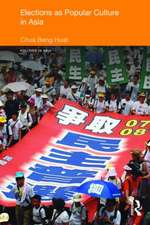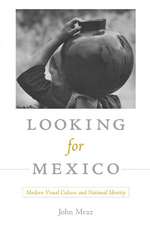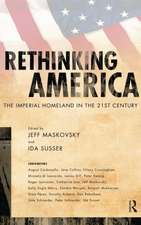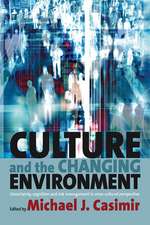Stigmas of the Tamil Stage – An Ethnography of Special Drama Artists in South India
Autor Susan Seizeren Limba Engleză Paperback – 10 apr 2005
Preț: 349.17 lei
Nou
Puncte Express: 524
Preț estimativ în valută:
66.81€ • 69.76$ • 55.30£
66.81€ • 69.76$ • 55.30£
Carte tipărită la comandă
Livrare economică 04-18 aprilie
Preluare comenzi: 021 569.72.76
Specificații
ISBN-13: 9780822334439
ISBN-10: 0822334437
Pagini: 464
Ilustrații: 62 illustrations (incl. 10 in colour), 1 table, 1 map
Dimensiuni: 157 x 234 x 29 mm
Greutate: 0.67 kg
Ediția:New.
Editura: MD – Duke University Press
ISBN-10: 0822334437
Pagini: 464
Ilustrații: 62 illustrations (incl. 10 in colour), 1 table, 1 map
Dimensiuni: 157 x 234 x 29 mm
Greutate: 0.67 kg
Ediția:New.
Editura: MD – Duke University Press
Cuprins
List of Illustrations xiii
Acknowledgments xv
Notes on Transliteration xxi
Introduction
Preface: A Conversation on Culture 1
Birth of This Project 9
Writing about Special Drama 12
Methods 14
Geographic Relations and the Historical Ethnographic Present 16
Why Comedy Is a Good Site for the Study of Culture 19
What Is Special Drama? 21
Making a Living 24
What Is Special about Special Drama? 26
Naming Matters 28
"Hey Drama People!": Stigma at Work 30
"Actors Have No Murai": A Proverbial Lack 32
Part One: The History and Organization of Special Drama 35
Part Two: Comedy 36
Part Three: Lives 38
Part One: The History and Organization of Special Drama
1. Legacies of Discourse: Special Drama and Its History 43
The Legend and Legacy of Sankaradas Swamigal 43
The History of Special Drama 47
Tamil Drama History, Stage One (of Undatable Roots) 49
Tamil Drama History, Stage Two 51
Tamil Drama History, Stage Three 52
Tamil Drama History, Stage Four 53
The Disciplined Life of the Drama Company 55
Life on the Margins of the Companies 60
Tamil Drama History, Stage Five: A New Historical Trajectory 62
The Legacy of the Company Model in Special Drama 64
Discourse of Vulgarity, Legacy of Shame 66
Context: The History of Modernity in Tamilnadu 70
Drama Actors Sangams 71
Why Actors Stand Still: Onstage Movement as the Embodiment of Vulgarity 77
The Stage Today 81
From Urban to Rurban 83
2. Prestige Hierarchies in Two and Three Dimensions: Drama Notices and the Organization of Special Drama 86
Early Drama Notices, 1891-1926 87
The Photograph Enters Notices, 1926-1936 92
English in the Vocabulary of Special Drama Artists: Jansirani and Sivakami 99
Midcentury Notices and Artists, 1942-1964 (M. K. Kamalam) 103
The Current Form of Notices: Roles and Ranks 111
The Photographic Style of Contemporary Notices 117
The Prestige Hierarchies of Artists as Pictured on Drama Notices 122
The Iconicity of the Contemporary Notice: Structured Spaces and Places 131
Drama Sponsorship and the Written Text of the Contemporary Drama Notice 132
The Working Network That Makes Special Drama Work 140
The Ritual Calendar of Drama Sponsorship 142
The Grounds of a Social Economy 144
3. Discipline in Practice: The Actors Sangam 146
Sivakami Winks… 146
…and Jansirani Disapproves 146
Competing Claims: A Matter of Bearing 149
Internalized Historiography: Artists' Discourses 152
Controlling Bodies and the Control of the Body 154
Discipline in Practice 157
Cross-Roles: Marked Men and Funny Women 165
Multiple Strategies 173
4. The Buffoon's Comedy: Jokes, Gender, and Discursive Distance 177
The Distances Appropriate to Humor 177
The Buffoon's Comedy Scene 180
Modernity and Its States of Desire 185
Layers of Meaning and the Meaning of Layers 198
The Ambivalence of Laughter: A Final Consideration 200
5. The Buffoon-Dance Duet: Social Space and Gendered Place 202
Mise-en-Scene 202
The Five Use-Areas and the Five Story Elements of the Duet 205
Architecture of the Stage: Inside, Outside, Behind, Above, and Beyond 205
Configuring the Stage: The Duet in Performance 207
The Dancer's Entrance 209
The Bumpy Meeting 212
The Meaning of a Bump between Men and Women 214
The Contest between Men and Women 216
Mutual Admiration and "Love Marriage" 223
Analogic Relations Onstage and Off 226
Conclusion 229
Coda 230
6. Atipiti Scene: Laughing at Domestic Violence 232
Atipiti 233
Anthropologists Viewing Laughter 234
The Ritual Frame of the Atipiti Scene 237
The Atipiti Scene 239
Act I: The Wife 239
Act II: The Husband 244
Act III: Their Meeting 250
A Discussion with the Artists 260
Four Theories of Spectatorship 264
Why Does the Audience Laugh? 267
An Audience Account 268
7. The Drama Tongue and the Local Eye 277
A Secret Language 279
Language Matters 281
Situating the Drama Tongue as an Argot 282
Researching the Drama Tongue 285
Terms of the Tongue 287
People of the Drama Tongue 293
What Do We Expect of a Secret Language? 296
Centered in Mobility, or, An Insider Language That Isn't 300
8. The Roadwork of Actresses 301
Offstage with Actresses 302
Narrative One: Regarding the Gender Dimensions of Booking a Drama 305
Work and the Internalization of Gendered Behavior 310
Narrative Two: Regarding Traveling to a Drama in a Private Conveyance 314
Roads and the Externalization of Gendered Behavior 316
Narrative Three: Regarding Traveling to a Drama in a Public Conveyance 319
Narrative Four: Regarding the Spatial Arrangements at a Drama Site 323
Theoretical Grounds 324
Narrative Five: Regarding Traveling Home in the Morning 327
Conclusion 329
9. Kinship Murai and the Stigma on Actors 334
An Excess Born of Lack 334
Kinship, Incest, and the Onstage Locus of Stigma 336
Known and Unknown People 349
Prestigious Patrilines and Activist Actresses 354
N. S. Varatarajan's Family 359
Karur Ambika's Family 354
Many Murai 363
Epilogue 365
Flower Garlands 365
Jansirani and Sivakami, 2001 368
Stigma and Its Sisters 371
Appendix I: Sangam Rules 375
Appendix 2: Tamil Transliteration of Buffoon Selvam's Monologue, 1 April 1992 381
Notes 385
Works Cited 417
Index 433
Acknowledgments xv
Notes on Transliteration xxi
Introduction
Preface: A Conversation on Culture 1
Birth of This Project 9
Writing about Special Drama 12
Methods 14
Geographic Relations and the Historical Ethnographic Present 16
Why Comedy Is a Good Site for the Study of Culture 19
What Is Special Drama? 21
Making a Living 24
What Is Special about Special Drama? 26
Naming Matters 28
"Hey Drama People!": Stigma at Work 30
"Actors Have No Murai": A Proverbial Lack 32
Part One: The History and Organization of Special Drama 35
Part Two: Comedy 36
Part Three: Lives 38
Part One: The History and Organization of Special Drama
1. Legacies of Discourse: Special Drama and Its History 43
The Legend and Legacy of Sankaradas Swamigal 43
The History of Special Drama 47
Tamil Drama History, Stage One (of Undatable Roots) 49
Tamil Drama History, Stage Two 51
Tamil Drama History, Stage Three 52
Tamil Drama History, Stage Four 53
The Disciplined Life of the Drama Company 55
Life on the Margins of the Companies 60
Tamil Drama History, Stage Five: A New Historical Trajectory 62
The Legacy of the Company Model in Special Drama 64
Discourse of Vulgarity, Legacy of Shame 66
Context: The History of Modernity in Tamilnadu 70
Drama Actors Sangams 71
Why Actors Stand Still: Onstage Movement as the Embodiment of Vulgarity 77
The Stage Today 81
From Urban to Rurban 83
2. Prestige Hierarchies in Two and Three Dimensions: Drama Notices and the Organization of Special Drama 86
Early Drama Notices, 1891-1926 87
The Photograph Enters Notices, 1926-1936 92
English in the Vocabulary of Special Drama Artists: Jansirani and Sivakami 99
Midcentury Notices and Artists, 1942-1964 (M. K. Kamalam) 103
The Current Form of Notices: Roles and Ranks 111
The Photographic Style of Contemporary Notices 117
The Prestige Hierarchies of Artists as Pictured on Drama Notices 122
The Iconicity of the Contemporary Notice: Structured Spaces and Places 131
Drama Sponsorship and the Written Text of the Contemporary Drama Notice 132
The Working Network That Makes Special Drama Work 140
The Ritual Calendar of Drama Sponsorship 142
The Grounds of a Social Economy 144
3. Discipline in Practice: The Actors Sangam 146
Sivakami Winks… 146
…and Jansirani Disapproves 146
Competing Claims: A Matter of Bearing 149
Internalized Historiography: Artists' Discourses 152
Controlling Bodies and the Control of the Body 154
Discipline in Practice 157
Cross-Roles: Marked Men and Funny Women 165
Multiple Strategies 173
4. The Buffoon's Comedy: Jokes, Gender, and Discursive Distance 177
The Distances Appropriate to Humor 177
The Buffoon's Comedy Scene 180
Modernity and Its States of Desire 185
Layers of Meaning and the Meaning of Layers 198
The Ambivalence of Laughter: A Final Consideration 200
5. The Buffoon-Dance Duet: Social Space and Gendered Place 202
Mise-en-Scene 202
The Five Use-Areas and the Five Story Elements of the Duet 205
Architecture of the Stage: Inside, Outside, Behind, Above, and Beyond 205
Configuring the Stage: The Duet in Performance 207
The Dancer's Entrance 209
The Bumpy Meeting 212
The Meaning of a Bump between Men and Women 214
The Contest between Men and Women 216
Mutual Admiration and "Love Marriage" 223
Analogic Relations Onstage and Off 226
Conclusion 229
Coda 230
6. Atipiti Scene: Laughing at Domestic Violence 232
Atipiti 233
Anthropologists Viewing Laughter 234
The Ritual Frame of the Atipiti Scene 237
The Atipiti Scene 239
Act I: The Wife 239
Act II: The Husband 244
Act III: Their Meeting 250
A Discussion with the Artists 260
Four Theories of Spectatorship 264
Why Does the Audience Laugh? 267
An Audience Account 268
7. The Drama Tongue and the Local Eye 277
A Secret Language 279
Language Matters 281
Situating the Drama Tongue as an Argot 282
Researching the Drama Tongue 285
Terms of the Tongue 287
People of the Drama Tongue 293
What Do We Expect of a Secret Language? 296
Centered in Mobility, or, An Insider Language That Isn't 300
8. The Roadwork of Actresses 301
Offstage with Actresses 302
Narrative One: Regarding the Gender Dimensions of Booking a Drama 305
Work and the Internalization of Gendered Behavior 310
Narrative Two: Regarding Traveling to a Drama in a Private Conveyance 314
Roads and the Externalization of Gendered Behavior 316
Narrative Three: Regarding Traveling to a Drama in a Public Conveyance 319
Narrative Four: Regarding the Spatial Arrangements at a Drama Site 323
Theoretical Grounds 324
Narrative Five: Regarding Traveling Home in the Morning 327
Conclusion 329
9. Kinship Murai and the Stigma on Actors 334
An Excess Born of Lack 334
Kinship, Incest, and the Onstage Locus of Stigma 336
Known and Unknown People 349
Prestigious Patrilines and Activist Actresses 354
N. S. Varatarajan's Family 359
Karur Ambika's Family 354
Many Murai 363
Epilogue 365
Flower Garlands 365
Jansirani and Sivakami, 2001 368
Stigma and Its Sisters 371
Appendix I: Sangam Rules 375
Appendix 2: Tamil Transliteration of Buffoon Selvam's Monologue, 1 April 1992 381
Notes 385
Works Cited 417
Index 433
Recenzii
Stigmas of the Tamil Stage is masterful, a paradigm of ethnographic scholarship and social analysis and a major contribution to the human sciences and to South Asian studies. A classic in the making. Lawrence Cohen, author of No Aging in India: Alzheimers, the Bad Family, and Other Modern ThingsSusan Seizers moving and unique perspective on the fate of popular cultural practices in an age and society dominated by the norms and prescriptions of bourgeois modernity makes her work important and insightful not just for scholars of South Asia but for all those who are interested in the general problematic of popular culture, performance traditions, and modernity globally.Sumathi Ramaswamy, author of The Lost Land of Lemuria: Fabulous Geographies, Catastrophic HistoriesSusan Seizer presents rich and intriguing material about a dramatic performance tradition at the same time that she provides smart, insightful, and sophisticated interpretations linking it to wider discussions. Stigmas of the Tamil Stage deserves to be read, discussed, and used to further debates in many fields of study.Paula Richman, editor of Many Ramayanas: The Diversity of a Narrative Tradition in South Asia
Notă biografică
Susan Seizer
Textul de pe ultima copertă
"Susan Seizer presents rich and intriguing material about a dramatic performance tradition at the same time that she provides smart, insightful, and sophisticated interpretations linking it to wider discussions. "Stigmas of the Tamil Stage" deserves to be read, discussed, and used to further debates in many fields of study."--Paula Richman, editor of "Many Ramayanas: The Diversity of a Narrative Tradition in South Asia"
Descriere
A feminist and performance studies-oriented ethnography of the on- and offstage lives of a group of traveling artists in southern India and their complex relation to their deviant status in the larger culture.
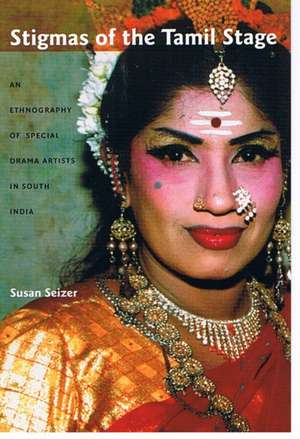

![Crime and Custom in Savage Society: [1926/1940]](https://i1.books-express.ro/bt/9780415488365/crime-and-custom-in-savage-society.jpg)

